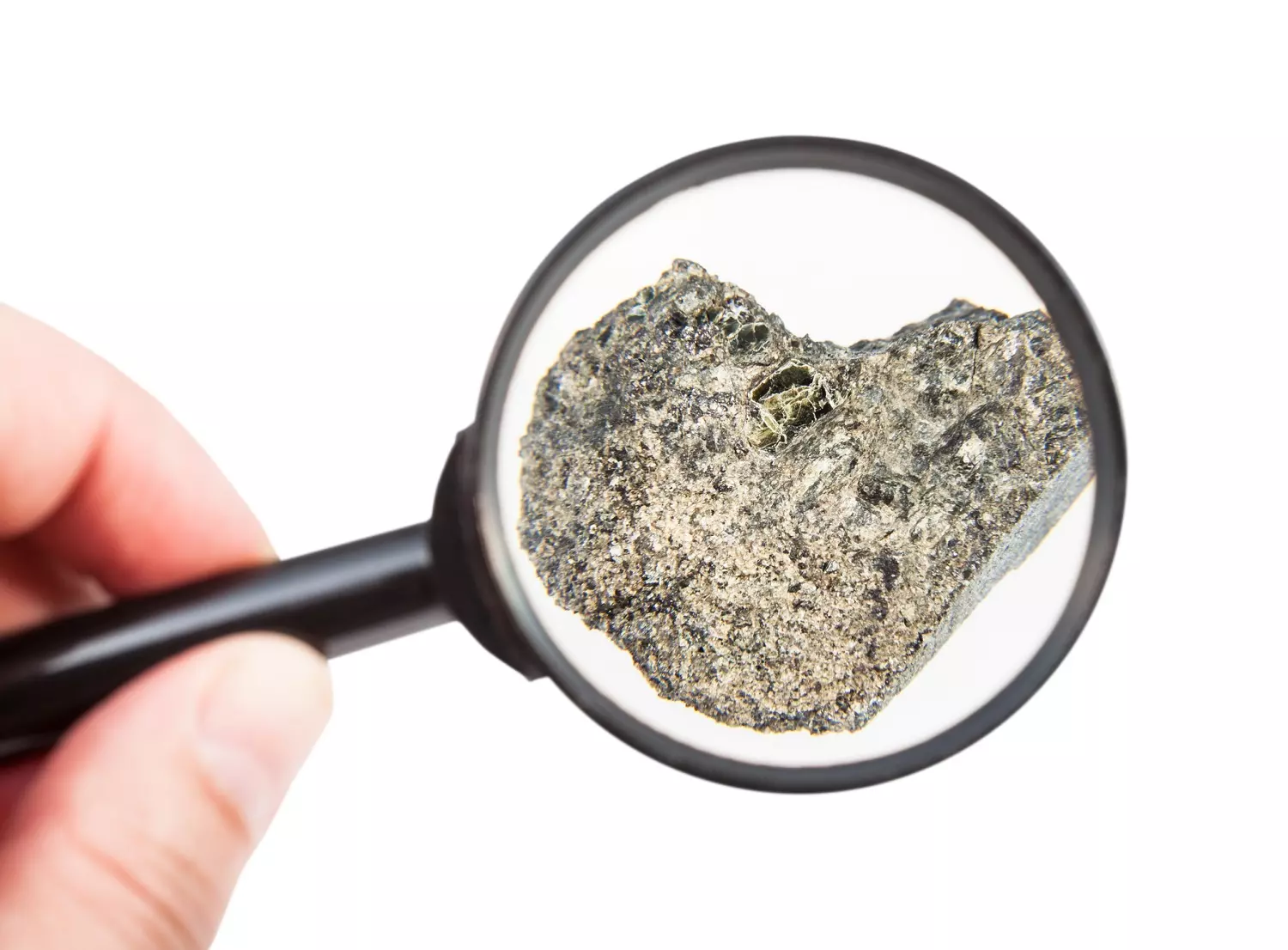In part one of this series we discussed two dating methods that are used to calculate the ages of rocks and fossils- relative and absolute. We pointed out that the equations used to calculate ages via absolute dating methods, or radiometric dating, rely on three unreasonable assumptions which are “plugged in” as constants. Just as in any math equation, the accuracy of the values one uses for constants will directly affect the accuracy of one’s result. What are these assumptions underlying radiometric dating?
Constant Rates of Radioactive Decay

The first assumption is that the rate of radioactive decay is known, and has been constant, since the rock formed. While it is true that radioisotope decay rates seem to be constant today, to make the assumption that radioisotope decay rates have always been constant throughout history (a proposed history of billions of years) is unreasonable.
We have evidence that at some point (or points) in the past we have experienced accelerated rates of decay. The RATE group (Radioisotopes and the Age of The Earth) discovered this when examining zircon crystals. Dr. Jeff Miller explains their findings in an article for Apologetics Press:
“The rate team had several zircon crystals dated by expert evolutionists using the uranium-lead evolutionary dating technique and found them to be 1.5 billion years old, assuming a constant decay rate. A by-product of the break down of uranium into lead is helium. Content analysis of the crystals revealed that large amounts of helium were found to be present. However, if the crystals were as old as the dating techniques suggested, there should have been no trace of helium left, since helium atoms are known to be tiny, light, unreactive, and able to easily escape from the spaces within the crystal structure.”
According to Roger Patterson, writing for Answers in Genesis:
“Helium escapes from crystals at a known, measurable rate. If those rocks were over a billion years old, as evolutionists claim, the helium should have leaked out of the rock.”
New Scientist reported in 2009 that physicist David Alburger found that the nuclear decay rate of silicon-32 actually changed with the seasons. Similarly, a Purdue physicist found that nuclear decay rates speed up in winter. The decay rates were found to be altered by the sun, but they are unsure as to exactly how- possibly an unknown particle that the sun emits.
Closed System
The second assumption is that the amounts of parent and daughter isotopes contained in a rock have not been altered (none gained or lost) by anything other than radioactive decay. This is what is called a “closed system,” meaning that the amount of the elements in the rock sample have never been affected by outside elements. So, in order to arrive at a correct date, this assumption requires that the elements in the rock sample have never- in the course of billions of years- been affected by weathering of the rock due to ground water, or diffusion of gases, lava flows, floods, mudslides, meteorite activity or anything else.

Is this a reasonable assumption? Dr. Miller refers to McDougall and Harrison’s “Geochronology and Thermochronology by the 40 Ar/39 Ar Method” published by Oxford University Press when he writes:
“Evolutionary geologists, again, recognize that this assumption oftentimes doesn’t hold up. According to Ian McDougall, professor of geology in the Research School of Earth Sciences at the Australian National University, and T. Mark Harrison, professor of geology in the Department of Earth and Space Sciences at the University of California, Los Angeles, ‘Departures from this assumption in fact are quite common, particularly in areas of complex geological history’ (1999, p. 11, emp. added). To suggest a closed system for a specimen that is believed to be very old is a reckless, unreasonable assumption, (1) when there is clear evidence that a closed system cannot be guaranteed, and (2) when, in fact, there is compelling evidence that ancient Earth was rocked by a global catastrophe that most certainly would have violated the ‘closed system’ assumption (cf. Whitcomb and Morris, 1961) and created an extremely ‘complex geological history.'”
Knowledge of Initial Conditions
The third assumption is that we know the original amounts of parent and daughter isotopes that were present when the rock was formed. More specifically, that the rock initially contained only the parent isotope and none of the daughter isotope.
Quoting Dr. Miller again:
“But how could one possibly substantiate an assumption about the initial conditions of a specimen’s decay process, especially when the commencement of its decay was hundreds or thousands (according to evolutionists, millions or billions) of years ago? Is it not possible, and even likely, that a specimen might have been initially composed of more than one element that blended together during a geologic phenomenon before that rock’s decay processes began?”
This assumption cannot be substantiated since no one was present when these rocks formed. It becomes particularly illogical when extrapolating billions of years into the past.
Conclusion
Dr. Miller is careful to clarify that assumptions are not all bad:
“Assumptions are oftentimes necessary in operational science, and they can be effective and productive in helping scientists to solve problems and make advancements and important breakthroughs; but assumptions must be made with caution.”
Miller continues:
“The standard practice of geologists today, in light of this, is to ‘do what you can with what you have.’ However, if the dating assumptions are too unrealistic to allow for an accurate date of anything, shouldn’t the dating methods be deemed untrustworthy or even abandoned, if that is where the evidence leads?”
At minimum, it seems to me that where assumptions necessarily exist, dogmatism should not.








You fail to describe the dating process correctly.
I have experience of working in a radiometric dating laboratory. This is nothing more than a misrepresentation of the reality of a very robust and rigours process.
So, I fail to recognise your description of radiometric dating.
You talk about the mathematics used, however you make no attempt to explain this. You admit the math is complicated, then reference this to algebra. I would be happy to give the exact formula if you require. Although a heightened understanding of math is needed.
A scientific assumption; an auxiliary hypothesis that is taken as true for the purposes of interpreting a particular test. It may be very difficult, if not impossible, to falsify conclusively.
“We have evidence that at some point (or points) in the past we have experienced accelerated rates of decay.” Really! why don’t Miller and co publish the evidence they have?
By observing the decay of radionuclides in the laboratory, we now know the unique decay rates for each radionuclide. There is no known explanation that claims decay rates are not constant. Of course over ~4.5 billion years it’s possible there may have been some tiny fluctuations. You use the radioisotope silicon 32 as an example. However there is no bearing on the value for silicon 32’s half-life. This is part of a decay chain anyway.
This is irrelevant and would not effect the half-lives of the isotopes used for dating. The half-life of each radionuclide used for dating, is a fundamental part of the process. However you fail to mention this.
I could easily address many other inaccuracies in your articles.
There are over 130 radiometric dating laboratories around the world. Normal practise would involve various dating methods on every sample, where possible in coordination with known dates.
Many samples are dated at more than one laboratory.
Your articles make me and my coworkers appear to not fully understand the dating technique, therefore producing inaccurate dates without caring.
Because I actually know the whole dating process, I can assure you it is an exact science!
I find it very disrespectful to write and misrepresent something you clearly understand so little about.
I would be happy to write a detailed explanation of the dating process if you like. You could then post as a reply. I always think its best to have both sides, don’t you?
Hi Melanie!
Thanks for your comment. I’m sorry you feel that I understand very little about the dating process. However, it seems that you may be misunderstanding my argument.
You write: “You talk about the mathematics used, however you make no attempt to explain this. You admit the math is complicated, then reference this to algebra. I would be happy to give the exact formula if you require. Although a heightened understanding of math is needed.”
My argument is not that the mathematical formula itself is incorrect, or that mathematical errors are being made. Rather, my point is that the accuracy of the formula and/or arriving at a mathematically accurate solution are of no consequence if the assumptions being “plugged into” the formulas are incorrect. My argument is essentially that the mathematically “correct” answer may very well be incorrect in reality with regard to finding the age of the subject being tested.
You write: “There is no known explanation that claims decay rates are not constant.”
Actually, evidence of this has been published by a team of Purdue/Stanford scientists. I included a link to an article discussing this in my article, but you may have missed it. I’ll re-post it here for your convenience: https://www.purdue.edu/newsroom/research/2010/100830FischbachJenkinsDec.html
These scientists actually confirm the very argument I am making in these articles which is, what scientists have up until very recently considered to be fact, has turned out no to be so. Fischbach notes, “…What is key here is that what was thought to be a constant actually varies and we’ve discovered a periodic oscillation where there shouldn’t be one.” He also says, “We haven’t known the solar neutrino to interact significantly with anything, but it fits with the evidence we’ve gathered as the likely source of these fluctuations…So, what we’re suggesting is that something that can’t interact with anything is changing something that can’t be changed.”
Again, these citations corroborate the very heart of my argument.
You may me interested in this additional citation from the article for your further research, “The Purdue team has ruled out the possibility of experimental error or an environmental influence on the detection systems that track the rate of decay as being responsible for the fluctuations and published a series of papers in the journals Astroparticle Physics, Nuclear Instruments and Methods in Physics Research, and Space Science Reviews.”
I am confident that your understanding of the dating process and the mathematics involved is impeccable, and I’m quite sure I could learn a lot from you about both. However, in order to effectively respond to the argument, you will need to specifically address the issue of the assumptions outlined: constant decay rates (unexpected fluctuations confirmed by the Purdue/Standford team), closed system, and knowledge of initial conditions.
Thanks!
Tiffany
So, my original comment was a very brief reply.
So maybe I should give a little background. I have a chemistry MSc.
OK, I didn’t mention the Purdue/Stanford article as it is irrelevant in any meaningful debate regarding radiometric dating. Something creationist pseudoscience sites love to do. However I also understand that dismissing it out of hand is also hard for you to accept.
Decay chains can be very complex. Silicon has twenty isotopes, the two stablest being Si-32 with a half-life of ~150 years, and Si-31 with a half-life of ~3 hours. All the remaining radioactive isotopes have half-lives that are not meaningful in any significant amount for this discussion. Silicon does not have any known nuclear isomers.
So to clarify. Their claims were based on the observation of permille-sized annual modulations in hand picked unstable decay rate measurements, which they tried to link with neutrino flux changes in phase with the orbital distance of Earth to the Sun. Fischbach et al. have progressively weakened their claims when counter-evidence proved them wrong at several instances
So for the moment let’s put silicon to one side and address your first “assumption” constant decay rates.
I shall first begin with a discourse on the underlying chemistry behind radionuclide decay, the precise mathematical law that this process obeys, and how that law is derived, both empirically and theoretically. The decay law was first derived empirically, courtesy of a large body of work by scientists such as Henri Becquerel, Marie Curie, Ernest Rutherford and others. Indeed, the SI unit of activity was named the Becquerel in recognition of that scientist’s contribution to the early days of the study of radionuclide decay, and 1 Bq equals one transformation (decay) per second within a sample of radionuclide. However, the underlying physics had to wait until the advent of detailed and rigorous quantum theories before it could be elucidated, and is based upon the fact that the nuclei of radionuclides are in an excited state with respect to the sum total of the quantum energy states of the constituent particles (which, being fermions, obey Fermi-Dirac statistics, and consequently, Pauli’s exclusion principle applies).
In order for the system to move to a lower energy state, and settle upon a stable set of quantum numbers, various transformations need to take place, and these transformations result in the nucleus undergoing specific and well-defined structural changes, involving the emission of one or more particles.
Empirical Determination Of The Decay Law
Initially, the determination of the decay law was performed empirically, by observing the decay of various radionuclides in the laboratory, taking measurements of the number of decay events, and plotting these graphically, with time along the x-axis, and counts along the y-axis. Upon performing this task, the data for many radionuclides is seen to lie upon a curve, and determination of the nature of that curve requires a little mathematical understanding.
To determine the nature of a curve, various transformations can be performed upon the data. The result of each of these transformations is as follows:
[1] Plot log^e(y) against x – if the result is a straight line, then the relationship is of the form:
log^e(y) = kx + C (where C is some constant, in particular, the y-intercept of the straight line)
which can be rewritten:
log^e(y) – log^e(C^0) = kx (where C = log^e(C^0))
which rearranges to:
y = C^0ekx
where C^0 is derived from the y-intercept of the straight line produced by the transformed plotting, and k is the gradient of the transformed line.
[2] Plot y against log^e(x) – if the result is a straight line, then the relationship is of the form:
y = k log^e(x) + C, where k is the gradient of the line, and C is the y-intercept of the straight line.
[3] Plot log^e(y) against log^e(x) – if the result is a straight line, then the relationship is of the form:
log^e(y) = k log^e(x) + C (where C is the y-intercept of the straight line thus produced)
This rearranges to:
log^e(y) – log^e(C^0) = k log^e(x) (where C = log^e(C^0))
Which in turn rearranges to:
log^e(y/C^0) = log^e(x^k)
Which finally gives us the relationship:
y = C^0x^k, where k is the gradient of the straight line produced by the transformed data, and C^0 is derived from the y-intercept of the straight line produced by the transformed data.
The above procedures allow us to determine the nature of the mathematical relationships governing large bodies of real world data, when those bodies of real world data yield curves as raw plots of y against x. By applying the relevant transformations to radionuclide decay data, it was found that transformation [1] transformed the data into a straight line plot and consequently, this informed the scientists examining the data that the decay law was of the form:
N = C^0e^kt
where C^0 and k were constants to be determined from the plot, and which were regarded as being dependent upon the particular radionuclide in question.
So, if we are start with a known amount of radionuclide, and observe it decaying, then each decay event we detect with a Geiger counter represents one nucleus undergoing the requisite decay transformation. Since the process is random, over a long period of time, decaying nuclei will emit α or β particles in all directions with equal frequency, so we don’t need to surround the material with Geiger counters in order to obtain measurements allowing a good first approximation to the decay rate. Obviously if we’re engaged in precise work, we do set up our experiments to do this, especially with long-lived nuclei, because the decay events for long-lived nuclei are infrequent, and we need to be able to capture as many of them as possible in order to determine the decay rate with precision. Let’s assume that we’re dealing with a relatively short-lived radionuclide which produces a steady stream of decay events at a reasonably fast rate, in which case we can simply point a single Geiger counter at it, and work out what proportion of these events we are actually capturing, because that proportion will be the ratio of the solid angle subtended by your Geiger counter, divided by the solid angle of an entire sphere (this latter value being 4π). When we have computed this ratio (let’s call it R), which will necessarily be a number less than 1 unless we have surrounded your sample with a spherical shell of Geiger counters, we then start collecting count data, say once per second, and plotting that data. In a modern setup we’d use a computer to collect this mass of data, in order to have as large a body of data as possible to work with. Before working with the raw data, we transform it by taking each of the data points and dividing it by R to obtain the true count.
Once the data has been collected, transformed and plotted, the end result should be a nice curve. At this point, we’re interested in knowing what sort of curve we have, and there are two ways we can determine this. One way is to take the transformed data set, comprising count values c1, c2, c3, … , cn, where n is the number of data points collected, compute the following values:
r1 = c-2 – c1
r2 = c3 – c2
r3 = c4 – c3
…
r^n-1 = cn – cn-1
Then plot a graph with r^k on the vertical axis, and c^k on the horizontal axis. This should give a reasonable approximation to a straight line, and the slope of that straight line, obtained via regression analysis, will give the first approximation to the decay constant k. At this point, we know we are dealing with a relationship of the form dN/dt = -kN, and you can then apply the integral calculus to that equation. Technically, what we are doing here is approximating the derivative by computing first differences.
However, as a double check, we can also perform a logarithmic regression on the data, plotting log^e(c^k) against time, which should also reveal a straight line, and again, the slope of that line will give you the value of k, which should be in good agreement with the value obtained earlier using the more laborious plot of r^k against c^k. In other words, applying the transformation [1] above to the data set, and extracting an exponential relationship from the data. Since we now know that the data is of the form:
log^eN = -kt
we can then derive the exponential form and check that it tallies with the integral calculus result.
Once we have that function coupling the decay rate to time, we can then work backwards, and feed in the values of the known starting mass and the experimentally obtained decay constant k, and see if the function obtained reproduces the transformed data points. If the result agrees with observation to a very good fit, we’re home and dry.
This is, essentially, how the process was done when the decay law was first derived, lots of data points were collected from observation of real radionuclide decay, and the above processes applied to that data, to derive the exponential decay law. When this was done for multiple radionuclides, it was found that they all obeyed the same basic law, namely:
N = N^0e^-kt
where N^0 is your initial amount of radionuclide, N is the amount remaining after time t, and k is the decay constant for the specific radionuclide.
Now, having determined this decay law empirically, would you like me to continue onto the theoretical derivation of the decay law and comparison with the above empirical results?
Melanie,
You write: “OK, I didn’t mention the Purdue/Stanford article as it is irrelevant in any meaningful debate regarding radiometric dating… However, I also understand that dismissing it out of hand is hard for you to accept.”
I disagree that the findings of the Purdue/Stanford team are irrelevant to any meaningful debate regarding radiometric dating. I’ll quote Fischbach again:
“…What is key here is that what was thought to be a constant actually varies and we’ve discovered a periodic oscillation where there shouldn’t be one.”
The point here is not whether or not the specific decay rate of Si-32 (actually chlorine-36 is cited as fluctuating as well in the article) has anything to do with radiometric dating. The point is that up until current day, all decay rates were believed to be constant. Now we have evidence that they are not. The opening line of the Purdue article actually reads, “ Radioactive decay rates, thought to be unique physical constants and counted on in such fields as medicine and anthropology, may be more variable than once thought.”
The very fact that we have current day fluctuations (thought to be impossible), which can and have been observed, make the claim that decay rates have been constant for billions of years in the past even more unjustifiable. We have absolutely no way of testing that.
Therefore, for me, you invalidate the rest of your explanation that follows when you say, “…for the moment let’s put silicon to one side and address your first ‘assumption’ constant decay rates.” In what way are you addressing the assumption, if you begin by setting aside the evidence that the assumption cannot be assumed?
You’re correct that your preliminary dismissal of this data will be hard for me to accept. In fact, it will be impossible for me to accept due to the fact that it reveals your commitment to only consider scientific information that confirms what you already believe to be true. Frankly, I can’t imagine anything that would handicap our discussion more.
I don’t have a degree in Chemistry, but I do have a degree in Finance. If you were to come to me for a loan, would you be interested in me writing you out an amortization formula to discuss what amount you can afford to borrow, the term of the loan, and your monthly payments, if I first tell you that my formula is based on a fixed interest rate, but the interest rate for your loan may very well be adjustable? Would you be interested at that point, in discussing my explanation of why my amortization formula is accurate and that my math is correct, if I refuse to determine whether or not your interest rate is going to be fixed or adjustable?
Tiffany,
I had to think about whether to reply.
You actually said, and I quote “The very fact that we have current day fluctuations (thought to be impossible), which can and have been observed, make the claim that decay rates have been constant for billions of years in the past even more unjustifiable. We have absolutely no way of testing that.”
So you never bothered to read my last reply!
Here goes anyway.
You appear to be basing your entire debate on a ten year old unsubstantiated paper. One insignificant falsified paper. That has no relevance in a sensible debate regarding radiometric dating. At this point I have no idea if you genuinely fail to understand, or you’re deliberately being obtuse.
Saying that, anyone that believes the Earth was formed before the Universe. Will never understand the complicated science behind Radiometric dating.
You will choose to believe what you want. Regardless of anything I, or indeed science says. If any evidence produced fails to fit the bibles narrative, then it’s subsequently dismissed, regardless of its authenticity.
Fischbach et al. research is in fact an excellent example of the scientific method in action. Nothing in scientific terms is proof or fact. Everything is open to scrutiny. Especially something as unconventional as a paper claiming the nuclear decay rate constant being re-evaluated. Even though you apparently fail to understand the paper didn’t actually claim this. The easiest person to fool is yourself.
They made claims about a new interaction. “The fifth force” by which neutrinos could affect decay constants, thus predicting changes in decay rates in correlation with variations of the solar neutrino flux.
Their claims were based on the observation of permille-sized annual modulations in hand picked unstable decay rate measurements, which they tried to link with neutrino flux changes in phase with the orbital distance of Earth to the Sun. Various metrologists have produced convincing counterevidence showing that decay constants are insensitive to the Earth–Sun distance.
Fischbach et al. have progressively weakened their claims when counterevidence proved them wrong at several instances.
Their attempts to link decay rate changes with neutrino-mediated effects from solar flares and solar storms have been contradicted by subsequent investigations. Also by lack of a plausible explanation on how phenomena at the surface of the Sun could influence the neutrino flux produced by fusion in its core.
Therefore their claims even though made in good faith have failed to be recognised by the scientific community. Thankfully everyone that believes in the scientific method, understands that research is on going. Ultimately it’s never ending. If we think we have found something that contradicts previous research. We don’t stop researching, the very opposite in fact.
However I understand why you use this as an example although the research has already been falsified. Once again, many scientists have attempted to influence the rate of radioactive decay by radically changing the pressure, temperature, magnetic field, acceleration, or radiation environment of the source. No experiment to date has detected any change in rates of decay.
I’m sure that you will not accept this. You will cling onto anything that supports your creationist belief. I don’t expect you to understand the complex decay chains involved. I’m sure
Fischbach et al. concluded that fluctuations (never verified and observed) to be insignificantly small, thus having no affect on the isotopes half-lives. Also, I don’t expect you to understand the reasons why their findings (unsupported), would have no affect on modern mass spectrometry dating methods. This is totally irrelevant to you anyway, as nothing will change a closed mind. You don’t want to learn anything new from this discussion!
As you have dismissed the rest of my earlier reply, I fail to see any valid reason to continue to produce further compelling evidence supporting the reliability of Radiometric dating. You would reject again as you have my previous reply. Looking for an abnormality that in reality is irrelevant. Nobel prizes have been awarded for work in radiometric dating, however you think know better!
However I do have a question that no one has ever answered in a sensible manner.
If radiometric dating is unreliable, then why don’t ICR, AiG simply acquire their own mass spectrometer?
They could then date dinosaur fossils 24/7 if they choose to do so.
Instead of attacking innocent people like me and claiming the process is unreliable. Why not use their own lab and instruments?
Why is that?
Melanie,
Let me open by issuing a warning that if you cannot refrain from devolving into demeaning language and name-calling your comments will no longer be approved for public viewing. I have no problem continuing to engage in discussion with you, but will only do so as long as we can conduct ourselves in a manner befitting respectful adults.
I’m not sure why you feel that my statements you cited indicate that I didn’t read your reply. I did read it. I also fully addressed it by noting that you admittedly dismissed the Purdue/Stanford paper out of hand before proceeding to continue with your explanation. What I pointed out, is that you cannot legitimately skip forward in your argument without sufficiently addressing the Purdue/Stanford paper. At least, not if you intend to be persuasive.
While I am certainly not “basing my entire debate” on what you refer to as a “ten year old unsubstantiated paper” (after all, even without the Purdue/Stanford paper I consider the findings of the RATE group to be compelling), I certainly don’t see the need to move on to other areas when you have yet to adequately respond to this one.
You state: “However I understand why you use this as an example although the research has already been falsified.”
I’m assuming that you are referring to your own opinion here since a 2016 article in Physics World, “Do solar neutrinos affect nuclear decay on Earth?” (https://physicsworld.com/a/do-solar-neutrinos-affect-nuclear-decay-on-earth/) and this compilation of papers on the “Variability of Nuclear Decay Rates” via MIT (http://web.mit.edu/redingtn/www/netadv/XperDecRat.html), still seem to indicate ongoing discussion.
This quote from the “Physics Word” piece is particularly relevant:
“The idea of fluctuating beta-decay rates is very controversial because for more than 80 years, radioactive substances have been thought to follow a fixed exponential decay, under all conditions. The theory of invariable decay constants was set by Ernest Rutherford, James Chadwick and Charles Ellis in Radiations from Radioactive Substances, published in 1930.”
The scientific community being loathe to consider an option that would set aside a long standing, widely held assumption is certainly nothing new. I don’t know who the author of this article is- Half Life: The Decay of Knowledge and What to Do About It (https://fs.blog/2018/03/half-life/) – but he illustrates my point beautifully. He definitely puts it more eloquently than I do, so perhaps his words will reach you where mine continue to fail:
“In The Half-Life of Facts: Why Everything We Know Has an Expiration Date, Samuel Arbesman (see our Knowledge Project interview) posits that facts decay over time until they are no longer facts or perhaps no longer complete. According to Arbesman, information has a predictable half-life: the time taken for half of it to be replaced or disproved. Over time, one group of facts replaces another. As our tools and knowledge become more advanced, we can discover more — sometimes new things that contradict what we thought we knew, sometimes nuances about old things. Sometimes we discover a whole area that we didn’t know about…Scientometrics shows us that facts are always changing, and much of what we know is (or soon will be) incorrect…Yet we all have a tendency to turn a blind eye when beliefs we hold dear are disproved and to pay attention only to information confirming our existing opinions.”
Here’s another quote from the “Physics World” article:
“…according to Hamish Robertson, director of the Center for Experimental Nuclear Physics and Astrophysics at the University of Washington, in Seattle… ‘Evidence that fits the hypothesis has been brought forward, while other evidence that does not fit (for example, long-term studies of the beta decay of tritium), is ignored.’”
Clearly Robertson is not in agreement with the Purdue/Stanford scientists. However, he acknowledges that evidence fitting their hypothesis has been presented. This seems to be something you disagree with him on. Correct? If so, how would you respond to Robertson’s statement?
You state: “I’m sure that you will not accept this. You will cling onto anything that supports your creationist belief.”
It’s unfortunate that you fail to see that we at least suffer from the same “bias” in this respect. While I have faith in a biblical creation worldview, you have faith in a uniformitarian/naturalistic worldview. Discussion of current radioactive decay rates is interesting, and naturally, research indicating fluctuating rates will be particularly interesting to creation scientists. It is also a very valid example of a historical truth that consistently applies to science- sometimes we don’t even know what we don’t know. The fact remains that holding a uniformitarian/naturalistic worldview requires an equal amount of faith since we can’t go back and scientifically prove these things in the past.
You ask: “…why don’t ICR, AiG simply acquire their own mass spectrometer? They could then date dinosaur fossils 24/7 if they choose to do so. Instead of attacking innocent people like me and claiming the process is unreliable. Why not use their own lab and instruments?”
It would be silly for me to respond on behalf of ICR or AiG. Frankly I find these questions a little odd and a lot ironic. You accuse ICR and AiG of “attacking innocent people like you,” yet you have come into an online community designed specifically for discussion centered around a biblical worldview, and liberally dealt insults with respect to my intelligence, as well as the intelligence of any individual who holds to a creationist worldview, etc. Since your argument seems to be with ICR and AiG specifically, it leaves me to wonder why you would not simply direct your questions to them? I also have to ask- if ICR or AiG were to conduct testing exclusively in their own labs, etc, would you accept their results as valid? Based on our discussion, I can’t imagine that you would ascribe much confidence to their findings.